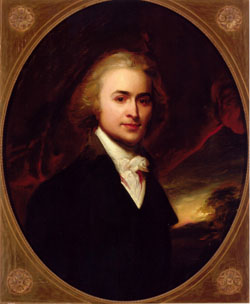

John Quincy Adams

John Quincy Adams was the oldest of John and Abigail Adams’ five children. His middle name “Quincy” came from Abigail’s maternal grandfather, Colonel John Quincy, after whom Quincy, Massachusetts is also named. John Quincy was born on July 11, 1767, in the house next to where his father had been born.
The American Revolution began when John Quincy was eight years old. While his father was gone away to Congress, he and his mother watched the Battle of Bunker Hill from a nearby field. It was she who primarily instilled in John Quincy his strong Christian ideals. “So well did his mother commit the Bible to his heart that it became for him a compass and anchor in a long life of service.” (The Christian History of the American Revolution John Quincy was a serious and studious child who “received his education principally by instruction from his distinguished father and gifted mother.” (Encyclopedia Americana) At age 11, he accompanied his father on a diplomatic mission to France. On their voyage they survived violent storms and a battle with a British ship, only to be shipwrecked off the coast of Spain. From there they rode to Paris on mules, a distance of 1,000 miles over the Pyrenees Mountains, a journey which took three months. As secretary to his father in Europe, John Quincy gained broad knowledge from study and travel. Under the close tutelage of his father, he learned six modern languages as well as Latin and Greek. In addition to being an accomplished linguist, John Quincy was a prolific diarist who often kept multiple diaries simultaneously, filling fifty-one volumes over sixty-nine years (amounting to nearly 15,000 pages). These diaries give a unique picture of the personalities and politics of the times. When he was just 14, John Quincy was chosen as an aide to the first U.S. diplomat to Russia. At the end of the American Revolution, he went with his father to the peace treaty conference between the United States and Great Britain. John Quincy was already an experienced traveler and diplomat, well informed about many cultures and topics of debate, by the time he arrived back home and entered Harvard College at age 19. As a scholar he was well versed in classical languages, history, and mathematics; he was also an excellent writer of both prose and poetry, and a fine speaker. Upon graduating, he began to practice law in Massachusetts and considered being a Harvard professor, although he preferred politics. It seems that John Quincy Adams was destined to follow in his father’s footsteps. John Quincy was elected a U.S. Senator in 1803. As newly appointed minister to Russia, John Quincy Adams set sail for St. Petersburg on August 5, 1809. He also served as minister to Great Britain. In 1823, as Secretary of State under James Monroe, Adams was the chief architect of the Monroe Doctrine. He also arranged the purchase of Florida from Spain. In 1824, Adams was a candidate for the U.S. presidency. Neither he, Andrew Jackson, William Crawford, nor Henry Clay received a majority in the electoral college. This meant the election had to be decided in the House of Representatives, and Adams was thus elected. At the time of John Quincy Adams’ presidency, not much was going on in foreign affairs which was his area of expertise. Instead, there was much internal strife with sectionalism and factionalism developing within the one and only political party. Adams tried to convince the nation to engage in a large scale cultural and economic development, and he was a strong supporter of improvements in the nation’s transportation system. While he was in office, the Erie Canal was opened, the Cumberland Road was completed, and the first railroads were built. John Quincy also did much in the areas of education and art, and was instrumental in establishing The Smithsonian Institution. After Jackson won the 1828 election, Adams retired to Quincy. In 1831, Adams became the first ever ex-President to be elected to the U.S. House of Representatives, an office which he kept until his death in 1848. John Quincy’s eloquence, persistence, and moral forcefulness brought an end in 1844 to the House “gag rule” on debate about slavery. Nevertheless, his strong beliefs about slavery did not sit well with members of Congress from the slave states. Adams was better known for his accomplishments as Secretary of State and later as a Congressman, than he was for his Presidency. But in spite of not being publicly popular at the time, he was respected for his high-mindedness and knowledge. Some consider him to have been the most intelligent man to ever inhabit the White House. Today, John Quincy Adams is most often remembered as, prior to the Presidency of George W. Bush, the only son of a former President to have been elected President. It seems that John Quincy Adams was actually way ahead of his time, since his bite-sized diary entries look a lot like tweets! On August 5, 2009, the Massachusetts Historical Society started posting John Quincy Adams’ line-a-day diary entries on Twitter, exactly 200 years after his first trip to Russia. The historians say they hope to connect a new online generation with Adams by bringing his life into the 21st century. Adams’ Twitter-ready entries include mentions of his favorite reads, memorable meals, weather updates, and the daily drama of months at sea:
Aug. 15, 1809: “Weather fine – wind scanty. Lat: 44-13. Long: 53-40. This afternoon I found the Caboose [ship’s galley] on fire.”
Aug. 31, 1809: “Calm and light winds. Pleasant weather. Lat: 59-23. Long: 17-15. Cimon and Lucullus. Cards.”
References:
Contact: . Thanks! Please click here for reprint permission.


These pages are a continuous work in progress.
|
Help Support this Site
and purchase items via our affiliate links. Thank you!
 
Thank you for visiting my |

